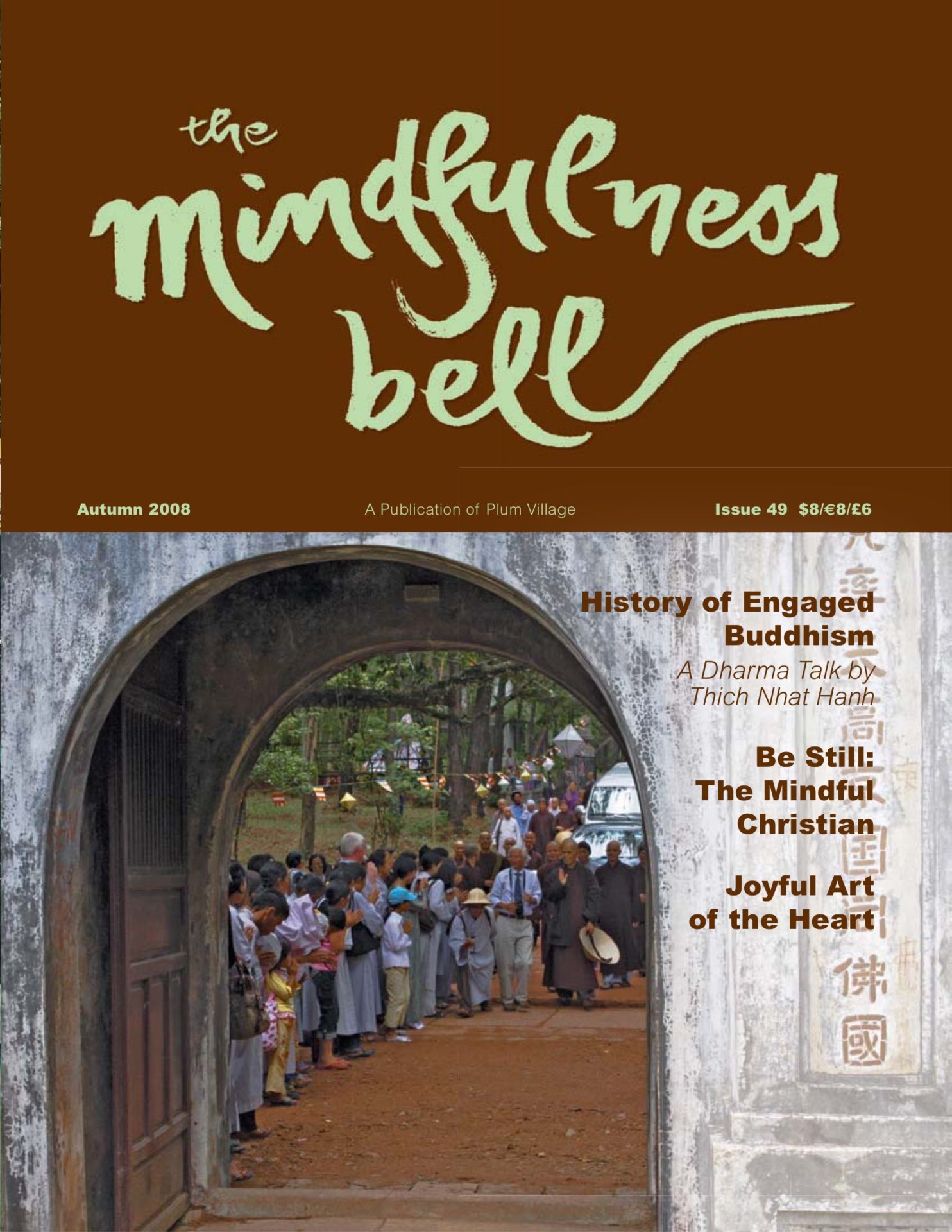Hanoi, Vietnam – May 6 -7, 2008
At the beginning of the seven-day English-language retreat in Hanoi, Thich Nhat Hanh gave a rare glimpse into his early career. This excerpt from two Dharma talks reveals Thay as a teacher, social activist, and prolific writer – and revolutionary advocate of Engaged Buddhism, also called Applied Buddhism.
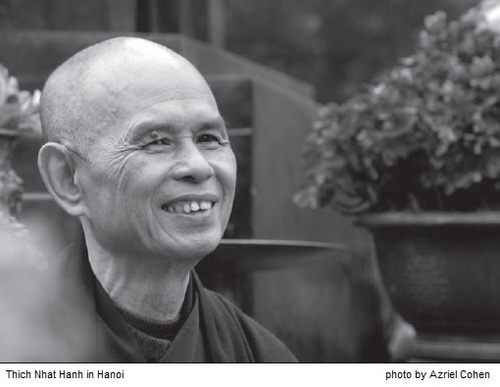
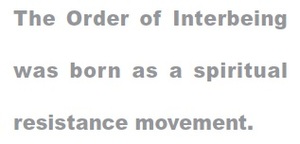
In 1949 I was one of the founders of the An Quang Buddhist Institute in Ho Chi Minh City,
Hanoi, Vietnam – May 6 -7, 2008
At the beginning of the seven-day English-language retreat in Hanoi, Thich Nhat Hanh gave a rare glimpse into his early career. This excerpt from two Dharma talks reveals Thay as a teacher, social activist, and prolific writer – and revolutionary advocate of Engaged Buddhism, also called Applied Buddhism.


In 1949 I was one of the founders of the An Quang Buddhist Institute in Ho Chi Minh City, and I taught the first class of novices. The temple was very simple, built of bamboo and thatch. The name of the temple was actually Ung Quang. A Dharma teacher came from Danang, the Venerable Tri Huu, and we both built Ung Quang temple. The war was going on between the French and the Vietnamese resistance movement.
Five years later, in 1954, the Geneva Accord was signed and the country was divided into two parts: the North was communist, and the South was anti-communist. Over one million people migrated from the North to the South, among them many Catholics. There was a lot of confusion in the country.
At the Ung Quang temple from time to time we received French soldiers who came to visit us. After Dien Bien Phu the war with the French ended, and it was agreed that the country should be divided and the French would withdraw from the country. I remember talking to the French soldiers. Many of them came to Vietnam and died in Vietnam.
A Fresh Look at Buddhism
In 1954 there was great confusion in the minds of people in Vietnam, especially the young people – monks, nuns, lay practitioners. The North was inspired by the Marxist-Leninist ideology. In the South, president Ngo Dinh Diem, a Catholic, was trying to run the country with another kind of ideology called “personalism.” It seemed that the ideological war had begun.
Buddhism is a very ancient tradition in Vietnam, and most of the people have a Buddhist seed in them. Mr. Vu Ngoc Cac, manager of a daily newspaper, asked me to write a series of articles about Buddhism. He wanted me to offer insight as to the spiritual direction we should take in order to deal with the great confusion in the country. So I wrote a series of ten articles with the title, “A Fresh Look at Buddhism.”
It is in this series of ten articles that I proposed the idea of Engaged Buddhism — Buddhism in the realm of education, economics, politics, and so on. So Engaged Buddhism dates from 1954.
At that time I did not use a typewriter, I just wrote in the oldfashioned way. And they came and they took the article, and the article was always printed on the front page with a big red title. The newspaper sold very, very well because people were very thirsty. They wanted spiritual direction because confusion was so huge.
Rose Tea and Fresh Corn
That series of articles was published as a book later on. Not long after, I visited Hue. Duc Tam, who had been in the same class as me at the Buddhist Institute, was the editor of another Buddhist magazine. His temple was on a small island in the Perfume River, Huong Giang, where they grow a very tasty kind of corn. He invited me to stay a few weeks in his temple. Every morning he offered me tea with a kind of rose — it’s a very tiny flower, but it smells nice when you put it in the tea. Every day we did walking meditation through the neighborhood, and we bought some fresh corn. He nourished me with rose tea and fresh corn, and he wanted me to write another series of articles on Engaged Buddhism! [laughs]
In fact, I wrote another series of ten articles with the title “Buddhism Today,” which was also on the theme of Engaged Buddhism. This series was translated into French by Le Vinh Hao, a scholar who lives in Paris. The title he took for the book is Aujourd’hui le Boudhisme.
In 1964 when I visited America to give a series of lectures, I met Thomas Merton, the Trappist monk, and I gave him a copy of Aujourd’hui le Boudhisme; he wrote a review.
Buddhism That Enters Into Life
In 1963-64, I was lecturing on Buddhism at Columbia University. The struggle led by the Buddhists for human rights ended the regime of President Diem. Maybe you have heard about the Venerable Thich Quang Duc, who immolated himself with fire, and who drew the attention of the whole world to the violation of human rights in Vietnam. That was a completely nonviolent movement for human rights. When the Diem regime fell, I was asked by my colleagues to come home and help.
So I went home. I founded Van Hanh University, and I published a book called Engaged Buddhism, a collection of many articles I had written before.
I think this is the first time you have this information. [laughs]
This is the beginning of 1964. I had written these articles before that, but I put them together and published under the title Engaged Buddhism, or Dao society. Di vao cuoc doi. Cuoc doi here is “life” or “society.” Di vao means “to enter.” So these were the words that were used for Engaged Buddhism in Vietnam: di vao cuoc doi, “entering into life, social life.”
Six months later I produced another book, Dao Phat hien dai hoa, “Buddhism updated,” “Buddhism renewed.” This is the Chinese — Buddhism made actual, the actualization of Buddhism. So all these terms, all these documents, have to do with what we call “Engaged Buddhism.” And after that I wrote many other books – Buddhism of Tomorrow. [laughs]
But at that time already, my name was banned by the government of the South, the anti-communist government, because of my activities for peace, calling for reconciliation between North and South. I became persona non grata. I could not go home anymore, and I was in exile.
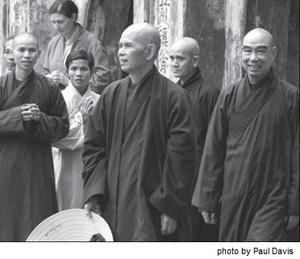
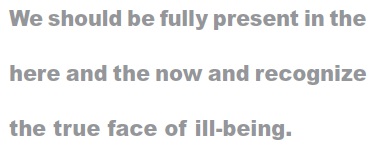
So my book, Buddhism of Tomorrow, could not be published in Vietnam under my name. I used a montagnard’s name — Bsu Danlu. You may wonder where that name came from. In 1956 we founded a practice center in the highland of Vietnam called Fragrant Palm Leaves Monastery, Phuong Boi. We bought the land from two montagnards, K’Briu and K’Broi. The name of the village where the Fragrant Palm Leaves Monastery was situated is Bsu Danlu.
Wisdom in the Here and Now
I continued to publish my books in Vietnam with many other names. I wrote a history of Vietnamese Buddhism in three thick volumes and I signed the name Nguyen Lang. So although I was away from the country thirty-nine years, I continued to write books and some of them were published in Vietnam under different names.
As we have said, the first meaning of Engaged Buddhism is the kind of Buddhism that is present in every moment of our daily life. While you brush your teeth, Buddhism should be there. While you drive your car, Buddhism should be there. While you are walking in the supermarket, Buddhism should be there — so that you know what to buy and what not to buy!
Also, Engaged Buddhism is the kind of wisdom that responds to anything that happens in the here and the now — global warming, climate change, the destruction of the ecosystem, the lack of communication, war, conflict, suicide, divorce. As a mindfulness practitioner, we have to be aware of what is going on in our body, our feelings, our emotions, and our environment. That is Engaged Buddhism. Engaged Buddhism is the kind of Buddhism that responds to what is happening in the here and the now.
A Fresh Take on the Four Noble Truths
We can speak about Engaged Buddhism in terms of the Four Noble Truths. The First Noble Truth is dukkha, ill-being. Traditionally Buddhist teachers have spoken of the First Noble Truth in this way: old age is suffering, sickness is suffering, death is suffering, separation from those you love is suffering. Leaving all those you love; wishing for something but never obtaining it. But these are old ways of describing the First Noble Truth. Now as we practice mindfulness we have to identify the kind of ill-being that is actually present. First of all we know there is a kind of tension in the body, a lot of stress. We can say that suffering today involves tension, stress, anxiety, fear, violence, broken families, suicide, war, conflict, terrorism, destruction of the ecosystem, global warming, etc.
We should be fully present in the here and the now and recognize the true face of ill-being.
The natural tendency is to run away from suffering, from ill-being. We don’t want to confront it so we try to escape. But the Buddha advises us not to do so. In fact he encourages us to look deeply into the nature of the suffering in order to learn. His teaching is that if you do not understand the suffering you cannot see the path of transformation, the path leading to the cessation of suffering.
All of us know that the First Noble Truth is ill-being and the Fourth Noble Truth is the path leading to the cessation of ill-being. Without understanding the First you never have the opportunity to see the path leading to the cessation of ill-being.
You should learn to come home to the present moment in order to recognize ill-being as it is; and as we practice looking deeply into the First Noble Truth, ill-being, we will discover the Second Noble Truth, the roots or the making of ill-being.
Each of us has to discover for himself or herself the cause of ill-being. Suppose we speak about our hectic life — we have so much to do, so much to achieve. As a politician, a businessman, even an artist, we want to do more and more and more. We crave success. We do not have the capacity to live deeply each moment of our daily life. We don’t give our body a chance to relax and to heal.
If we know how to live like a Buddha, dwelling in the present moment, allowing the refreshing and healing elements to penetrate, then we will not become victims of stress, tension, and many kinds of disease.
You can say that one of the roots of ill-being is our incapacity to live our life deeply in each moment.
When we have a lot of tension and irritation in us we cannot listen to the other person. We cannot use loving speech. We cannot remove wrong perceptions. Therefore wrong perceptions give rise to fear, hate, violence, and so on. We have to identify the causes of our ill-being. This is very important work.
Suppose we speak of suicide, of broken families. We know that when communication becomes difficult between husband and wife, father and son, mother and daughter, people are no longer happy. Many young people fall into despair and want to commit to suicide. They don’t know how to handle despair or their emotions, and they think that the only way to stop suffering is to kill oneself. In France every year about 12,000 young people commit suicide, just because they can’t handle their emotions like despair. And their parents don’t know how to do it. They don’t teach their children how to deal with their feelings, and even school teachers don’t how to help their students to recognize and hold their emotions tenderly.
When people cannot communicate they don’t understand each other or see the other’s suffering and there is no love, no happiness. War and terrorism are also born from wrong perceptions. Terrorists think that the other side is trying to destroy them as a religion, as a way of life, as a nation. If we believe that the other person is trying to kill us then we will seek ways to kill the other person first in order not to be killed.
Fear, misunderstanding, and wrong perceptions are the foundation of all these violent acts. The war in Iraq, which is called anti-terrorist, has not helped to reduce the number of terrorists. In fact the number of terrorists is increasing all the time because of the war. In order to remove terrorism you have to remove wrong perceptions. We know very well that airplanes, guns, and bombs cannot remove wrong perceptions. Only loving speech and compassionate listening can help people correct wrong perceptions. But our leaders are not trained in that discipline and they rely on the armed forces to remove terrorism.
So looking deeply we can see the making of ill-being, the roots of ill-being, by recognizing ill-being as the truth and looking deeply into its nature.
The Third Noble Truth is the cessation of ill-being, which means the presence of well-being — just as the absence of darkness means the presence of light. When ignorance is no longer present, there is wisdom. When you remove darkness, there is light. So the cessation of ill-being means the presence of well-being, which is the opposite of the First Noble Truth.
The teaching of the Buddha confirms the truth that well-being is possible. Because there is ill-being, well-being is possible. If ill-being is described first in terms of tension, stress, heaviness, then well-being is described as lightness, peace, relaxation – la détente. With your body, breath, feet, and mindfulness you can reduce tension and bring about relaxation, lightness, peace.
We can speak of the Fourth Noble Truth in very concrete terms. The methods of practice enable us to reduce tension, stress, unhappiness, as seen in the Fourth Noble Truth, the path. Today’s Dharma teachers may want to call it the path of well-being. The cessation of ill-being means the beginning of well-being — it’s so simple!
From Many Gods to No God
I would like to go back a little bit to the history of Engaged Buddhism.
In the nineteen-fifties I began to write because people needed to have spiritual direction to help them overcome their confusion. One day I wrote about the relationship between religious belief and the ways we organize our society. I described the history of the evolution of society.
First, our society was organized in groups of people called tribes. Over time, several tribes would come together and finally we set up kingdoms, with a king. Then the time came when we had enough of kings and we wanted to create democracies or republics.
Our religious beliefs had been changing along the way. First of all, we had something parallel to the establishment of tribes — polytheism, the belief that there are many gods and each god has a power. You are free to choose one god to worship, and that god will protect you against the other gods and the other tribes.
When we form kingdoms, then our way of belief changes also — monotheism. There’s only one God, the most powerful God, and we should worship only one God and not many gods.
When we come to democracies, there’s no king anymore. Everyone is equal to everyone else, and we rely on each other to live. That is why monotheism is changing to the belief in interdependence — interbeing — where there is no longer God. We are fully responsible for our life, for our world, for our planet. I wrote things like that during the time I was trying to build up Engaged Buddhism.
Birth of the Order of Interbeing
In 1964, we established the Order of Interbeing. The birth of the Order of Interbeing is very meaningful. We need only to study the Fourteen Precepts or Mindfulness Trainings in order to understand why and how the Order of Interbeing was established.
At that time the war was going on very fiercely. It was a conflict between ideologies. The North and South each had their own ideology; one side was Marxism-Leninism, the other, personalism and capitalism. Not only did we fight with ideologies imported from the outside, but we also fought with weapons imported from the outside — guns and bombs from Russia, China, and America. As Buddhists who practice peace and reconciliation, brotherhood and sisterhood, we did not want to accept such a war. You cannot accept a war where brothers are killing brothers with ideologies and weapons imported from the outside.
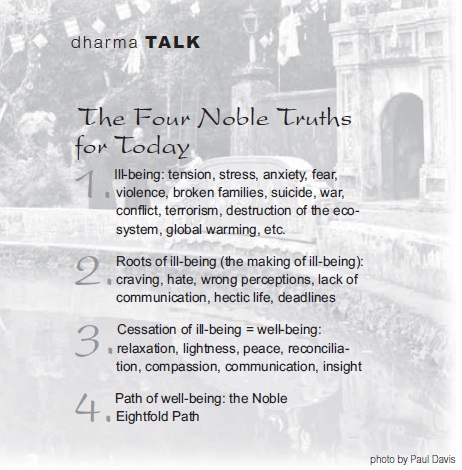
The Order of Interbeing was born as a spiritual resistance movement. It’s based completely on the teachings of the Buddha. The First Mindfulness Training — non-attachment to views, freedom from all ideologies — was a direct answer to the war. Everyone was ready to die and to kill for their beliefs.
The First Mindfulness Training: “Aware of the suffering created by fanaticism and intolerance, we are determined not to be idolatrous about or bound to any doctrine, theory, or ideology, even Buddhist ones…”
This is the lion’s roar!
“Buddhist teachings are guiding means to help us learn to look deeply and to develop our understanding and compassion. They are not doctrines to fight, kill, or die for.”
The teaching of the Buddha from the Nipata Sutra concerning views is very clear. We should not be attached to any view; we have to transcend all views.
Right View, first of all, means the absence of all views. Attachment to views is the source of suffering. Suppose you climb on a ladder, and on the fourth step you think you are already at the highest level. Then you are stuck! You have to release the fourth step in order to be able to get up to the fifth step. To be scientific, scientists have to release what they have found in order to come to a higher truth. This is the teaching of the Buddha: When you consider something to be the truth and you are attached to it, you must release it in order to go higher.
The basic spirit of Buddhism is non-attachment to views. Wisdom is not views. Insight is not views. We should be ready to release our ideas for true insight to be possible. Suppose you have notions about impermanence, non-self, interbeing, the Four Noble Truths. That may be dangerous, because these are only views. You are very proud that you know something about the Four Noble Truths, about interbeing, about interdependent origination, about mindfulness, concentration, and insight. But that teaching is only a means for you to get insight. If you are attached to these teachings, you are lost. The teaching about impermanence, nonself, interbeing, is to help you to get the insight of impermanence, non-self, and interbeing.
The Buddha said, “My teaching is like the finger pointing to the moon. You should be skillful. You look in the direction of my finger, and you can see the moon. If you take my finger to be the moon, you will never see the moon.” So even the Buddhadharma is not the truth, it’s only an instrument for you to get the truth. This is very basic in Buddhism.
War is the outcome of attachment to views, of fanaticism. If we look deeply into the nature of the war in Iraq, we can see that it is also a religious war. People are using religious belief to back up the war. Mr. Bush was supported by many [right-wing Christian] evangelists. The resistance fighters and the terrorists in Iraq are backed up by their Muslim belief. So this is somehow a religious war. Peace cannot exist if we maintain our fanaticism concerning our views.
Lotus in a Sea of Fire
In 1965 I wrote a small book on the war in Vietnam, Vietnam: Lotus in a Sea of Fire, published by Hill and Wong in America. The war in Vietnam was raging, it was an ocean of fire. We were killing each other; we allowed American bombers to come and destroy our forests, our people. We allowed weapons from China and Russia to come. But Buddhism was trying to do something. Those of us who did not accept the war wanted to do something to resist the war.
Buddhists did not have radio or television stations. There was no way for them to express themselves.
Whoever is listening, be my witness:I do not accept this war,let me say this one more time before I die.
These are lines in my poems.
Our enemies are not men.
Our enemies are hate, fanaticism, violence. Our enemies are not men. If we kill men, with whom shall we live?
The peace movement in Vietnam badly needed international support, but you could not hear us over there. So sometimes we had to burn ourselves alive to tell you that we didn’t want this war. Please help stop this war, this killing of brothers by brothers! Buddhism was like a lotus flower trying to survive in an ocean of fire.
I translated the book into Vietnamese, and an American friend in the peace movement helped bring that book to Vietnam. The book was printed underground and many young people tried to circulate that book as an act of resistance.
Sister Chan Khong, who was a professor of biology in Hue University, brought a copy to Hue for a friend. She was arrested and put into prison because she owned one copy of that book. Later on she was transferred to a prison in Saigon.
The School of Youth for Social Service
Young friends came to me and asked me to publish my poems about peace. They called it anti-war poetry. I said okay, if you want to do it, please do. They collected about fifty or sixty poems of mine on this topic and submitted them to the government of South Vietnam. Fifty-five of the poems were censored. Only a few were left. But our friends were not discouraged and they printed the poems underground. The book of poetry sold very, very quickly. Even some secret police liked it, because they also suffered from the war. They would go to the bookstore and say, “You shouldn’t display them like this! You should hide them behind the counter!” [laughs]
Radio stations in Saigon, Hanoi, and Beijing began to attack the poems because they called for peace. No one wanted peace. They wanted to fight to the end.
In 1964 we also established the School of Youth for Social Service. We trained thousands of young people, including monks and nuns, to go to the countryside and help the peasants rebuild their villages. We helped them in four aspects: education, health, economics, and organization. Our social workers went to a village and played with the children and taught them how to read and write and sing. When the people in the village liked us, we suggested building a school for the children. One family gave a few bamboo trees. Another family brought coconut leaves to make a roof. Then we began to have a school. Our workers did not receive a salary. After setting up a school in the village, we set up a dispensary where we could dispense rudimentary medicines to help the people. We brought into the village students of medicine or a doctor and tried to help one or two days. We also organized cooperatives and tried to teach people the kind of handicrafts they could do in order to increase the income of the family.
We have to begin with ourselves, from the grassroots. The School of Youth for Social Service was founded on the spirit that we don’t need to wait for the government.
A New Youth Organization in Europe
We trained many young people, including young monks and nuns. Finally we had more than ten thousand workers working from Quang Tri to the south. During the war we helped sponsor more than ten thousand orphans. That is part of Engaged Buddhism — the young people.
This year we intend to set up an organization of young Buddhists in Europe: Young Buddhists for a Healthy and Compassionate Society. So many young people have come to us, to our retreats in Europe, America, and Asia. Now we want to organize them. They will use the Five Mindfulness Trainings as their practice, and they will engage themselves into society — to help produce a healthier society, one with more compassion.
If my friends here are inspired by the idea, then please, when you go home, invite the young people to set up a group of Young Buddhists for a Healthy and Compassionate Society.
Last month we went to Italy, and we had one day of practice with the young people in the city of Napoli [Naples]. The five hundred young men and women who came to practice with us loved it! They are ready to engage in the practice of peace, helping to produce a healthier, more compassionate society.
Our young monks and nuns will also be involved in that organization.
Foundation of an Institute of Applied Buddhism
We have also set up a European Institute of Applied Buddhism. I hope that during this retreat, Sister Annabel, Chan Duc, will offer a presentation on the Institute of Applied Buddhism. We shall have campuses in America and Asia also. Everyone who has successfully completed the three-month retreat in Plum Village or Deer Park will be given a certificate of completion issued by the European Institute of Applied Buddhism.
The Institute of Applied Buddhism will offer many interesting courses. You might like to help organize a course in your area; we will send Dharma teachers. One example is the twenty-one-day course for young men and women who are preparing to set up a family. There they learn how to make their conjugal life into a success.
There will be courses for those who have been diagnosed with AIDS or cancer, so that they can learn how to live with their sickness. If you know how to accept and live with your sickness, then you can live twenty, thirty more years.
There will be courses for businesspeople, for school teachers, and so on.
This kind of certificate will help you to become an official Dharma teacher. One day you might be inspired to become a Dharma teacher, to go out and help people, to be a continuation of the Buddha.
Nowadays we are using the term “Applied Buddhism,” which is just another way of referring to Engaged Buddhism.
Transcribed by Greg Sever. Edited by Janelle Combelic and Sister Annabel.
To request permission to reprint this article, either online or in print, contact the Mindfulness Bell at editor@mindfulnessbell.org.


